I’m fascinated by the idea of the city as a palimpsest – a parchment scraped down to be used again with signs of previous lives grinning through.
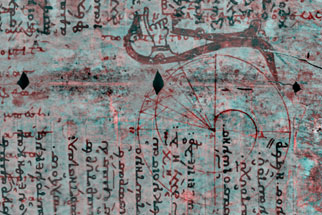
On the 1000-year-old Archimedes Palimpsest, previously unknown works by the Greek mathematician were poorly erased then overwritten with religious texts (http://www.pbs.org/)
Old street furniture illustrates this perfectly: usually it will be discarded if it doesn’t fit the current style guide but where it is allowed to remain it can tell us much about the layering of time.
Gybson’s Conduit on the boundary wall of Bullards Anchor Quay Brewery in Westwick Street once faced the road but when the brewing hall was converted into apartments in the 1980s the pump was restored [1] and re-sited to face into the development. This early Renaissance monument was built by Norwich Sheriff and brewer, Robert Gybson. It appears to be a philanthropic gesture (‘for the ease of the common people’) but it was actually a condition of buying the site on which St Lawrence’s Well had stood since at least the time of Edward the Confessor [2, 3]. Gybson seems to have been an angry man and for ‘failing to be buxom to the mayor‘ he was deprived of the freedom of the city and condemned ‘forever henceforth to be a foreigner‘ [2]. Coo!
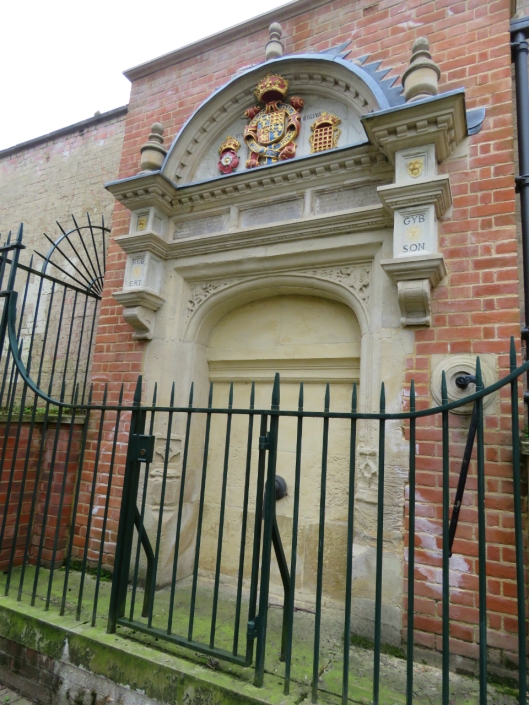
In 1860, John Henry Gurney erected this drinking fountain and obelisk to mark the site of an earlier wellhead (ca 1700-1850) that had raised water to be stored for the higher parts of the city [3].

The Gurney Drinking Fountain and Obelisk (1860) in Tombland
Sewell Park – the triangle of land between Constitution Hill and St. Clement’s Hill –was given to the city in 1908 by the Sewell family. Anna Sewell wrote Black Beauty when she lived about a mile away at Old Catton. The triangular horse trough – now a flower bed – that guards the park entrance is doubly appropriate.
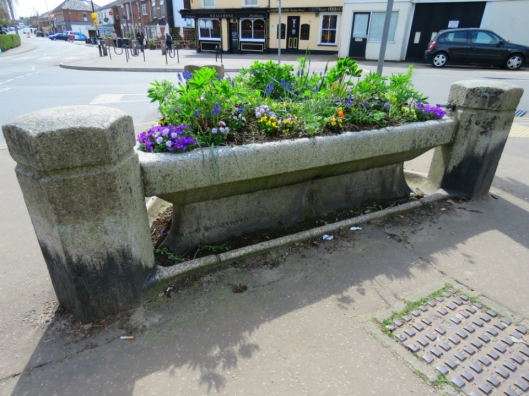
Black Beauty was published by local printing firm Jarrolds and Anna Sewell’s name is commemorated on one of the shields decorating the first floor of Jarrolds department store in London Street.
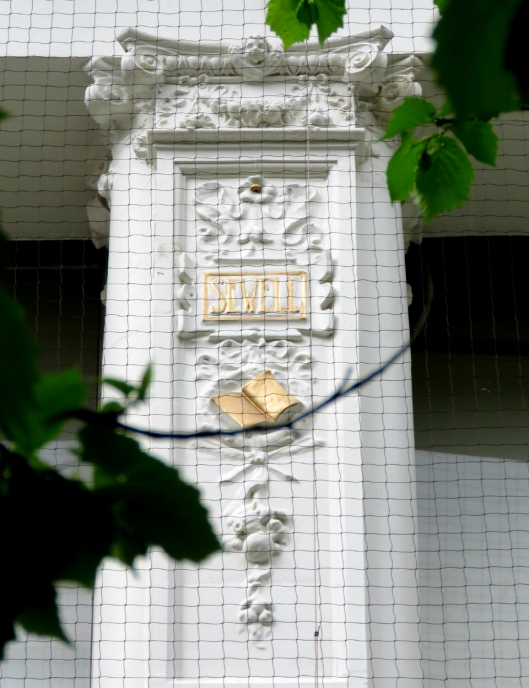
The trough on Castle Meadow, commemorating the popular Dr Darrell, was moved from outside his practice at All Saints Green [4]. It is reminiscent of a time when water troughs were placed along the road between the railway station and the old cattle market, beneath which Castle Mall now stands.

Following John Snow’s pioneering example of epidemiology in 1854, when he mapped an outbreak of cholera to a particular pump in London’s Soho [5], the importance of clean public water was foremost in the Victorian mind. Erected in 1860, this Portland Stone fountain outside St George Colegate was for public consumption: the marble basin for people and the troughs beneath for dogs.
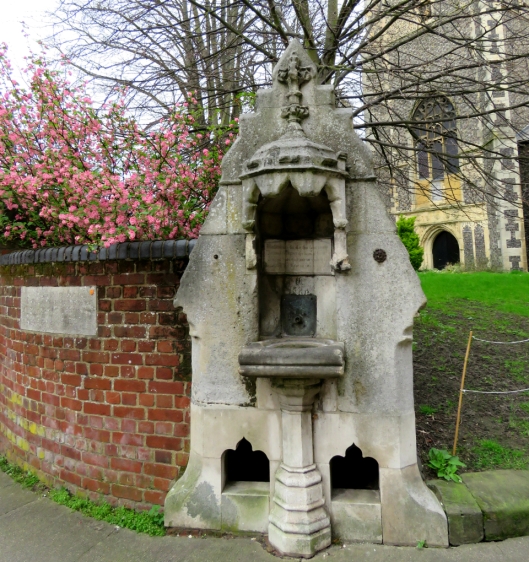
Presented by Mr JC Barnham, designed by architects Messrs Benest and Newton, and sculpted by Mr. Joseph Stanley of Norwich
Bearing in mind John Snow’s findings about the source of water, this parish pump – patented by Shalder of nearby Redwell Street – is worryingly situated next to the raised burying ground of St John Maddermarket. The water was once described as ‘pure essence of churchyard’ [2].

At a time when potable water was only just being piped into some homes, the need for fresh drinking water for the poor was often met by philanthropic commissions. Charles Pierre Melly had already provided many drinking fountains in Liverpool and in 1859 he presented Norwich with this fountain situated at the east end of the Guildhall [6].

FH fire hydrant signs are everyday parts of the streetscene but this FP sign in Unthank Road refers to an earlier ‘fire plug’. The small stretch of railings to which it is attached only survived because of the fire hydrant sign – most other railings and gates having been removed in WWII in a morale-boosting bid to make guns. However, the inferior quality of the metal was such that it was likely used for other purposes, if not dumped in the Thames [7].
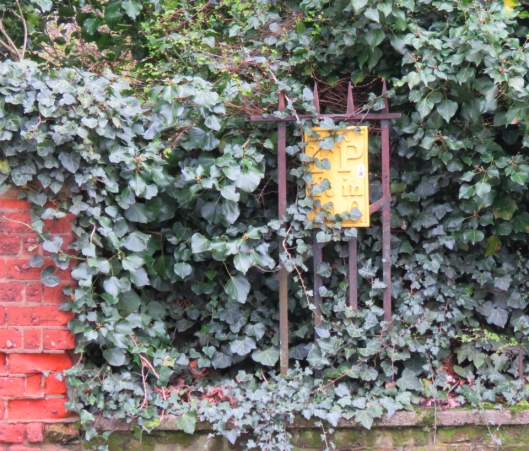
Near Bay Cottage, 14 Unthank Road
… and to round off the water theme, what is thought to be the earliest example of a concrete pissoir is now closed [2].

St Crispins Road near Barn Road roundabout
Due to that programme of scrappage in WWII there are precious few examples of locally-sourced ironwork on our streets. These curvaceous Art Nouveau-like railings around St Giles on the Hill reflect the flowing tracery of the beautiful east window from the Curvilinear Decorated period of the early C14 [8]
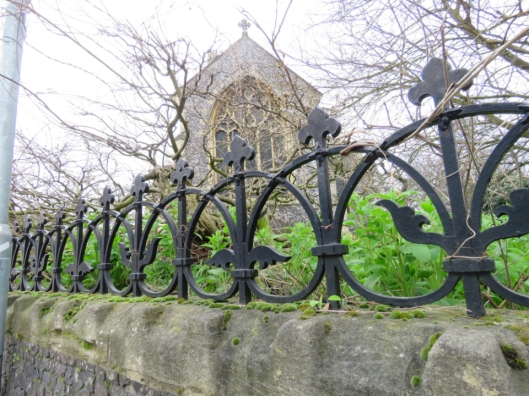
Some domestic gates have survived; Mill Hill Road has several examples, some refurbished. The gate below, with inverted curve, is a common pattern still copied when gates are replaced.
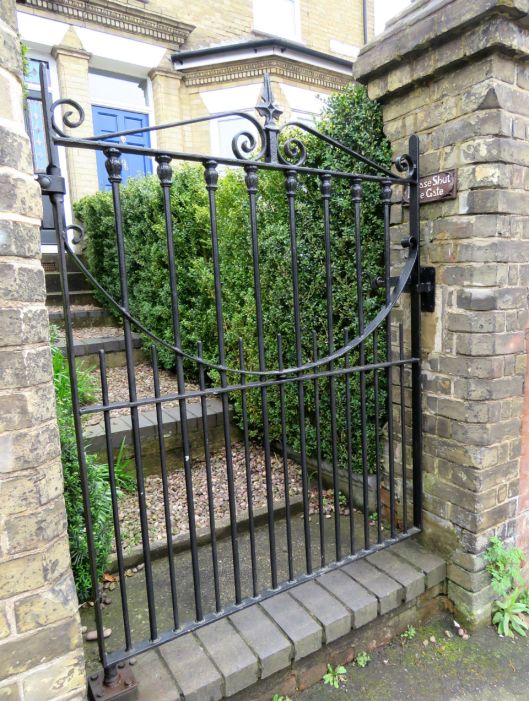
From a time, pre-Ocado, when tradesmen brought your orders to your (back) door …
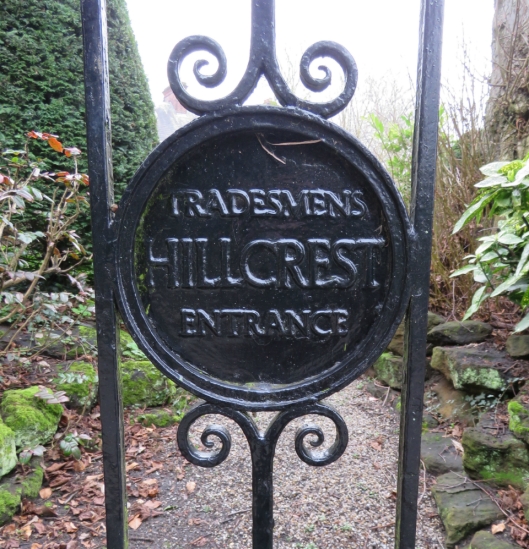
Mount Pleasant
Clarendon Road has some of the best examples of Victorian ironwork.
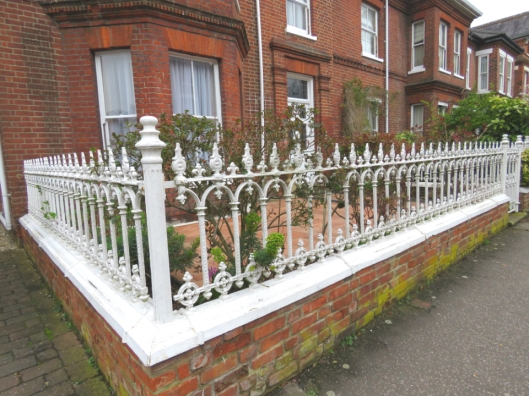
Clarendon Road
Again on Clarendon Road, these cast-iron railings and gates separate two fine Victorian houses from the roadway. But further examples of street furniture can just be glimpsed in the side alley: a bollard and a puzzling pipe.
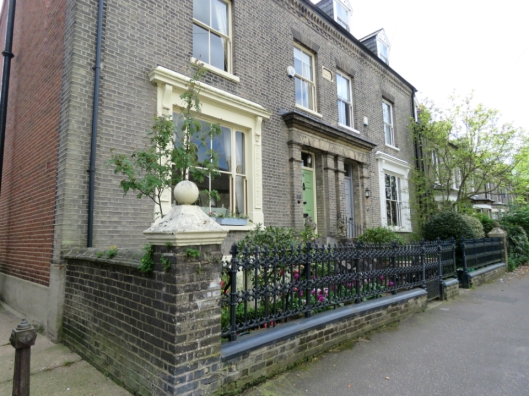
Another fine set of cast-iron railings on Clarendon Road. Just creeping into shot is a bollard (bottom left) and a curious pipe (top left).
First, the bollards. The Norwich City Council’s Streetscape Manual (2006) [10] mentions two designs: a plain octagonal post – generally painted dark green – used in the city centre, and a more ornate cast-iron bollard that was photographed by George Plunkett in 1931 and is probably Victorian [11]. Here, just outside the city walls, in the Heigham Grove Conservation Area, two of these latter bollards guard the alleyway between Clarendon Road and Neville Street. Two years ago I wrote about the bollards when local residents campaigned against the council’s plan to remove them to allow access for a mechanical street sweeper [11].
 It’s worth repeating the message that vestiges of a previous age are a vital part of the feel, the texture, of the streetscape. This design of bollard is entirely appropriate to one of the city’s finest late Victorian streets – as recognised in the council’s own planning appraisal:
It’s worth repeating the message that vestiges of a previous age are a vital part of the feel, the texture, of the streetscape. This design of bollard is entirely appropriate to one of the city’s finest late Victorian streets – as recognised in the council’s own planning appraisal:
“Several surviving cast iron railings along Clarendon Road are particularly fine and rare examples of once common Victorian ironwork found in Norwich cast by local firms such as Barnard, Bishop and Barnard(s)” [9].
This more ornate version can be found around churchyards, such as St Peter Mancroft and St Gregory’s but it can also be found at secular locations like Bishop Bridge (below) and the steps to the Castle at Davey Place.

- A convocation of traditional cast-iron bollards on Bishop Bridge. (Note the electric ‘gas’ lamp).
The historic Norwich Lanes [12] have been delineated by painting the modern octagonal bollards red instead of the more usual green. This references the colour of the plant dye, madder, that was so important to the city’s once-thriving cloth industry. Twenty-one of these bollards are crowned with bronze sculptures designed by Oliver Creed [13].
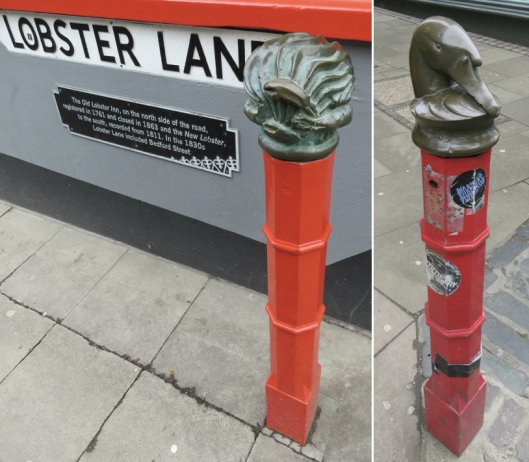
Oliver Creed’s bronze capitals to red bollards in Lobster Lane (L) and Swan Lane (R).
Within the jurisdiction of Norwich Cathedral, distinctive canon-style, cast-iron bollards are used. Since the partnership of Norwich ironfounders, John Francis & Thomas Blyth, was dissolved in 1840 the bollards must be at least 178 years old [14].

Back in the alleyway on Clarendon Road we glimpsed what was a tall, cast-iron stench pipe. If we think of such pipes at all we probably think of vent pipes that extend above the eaves. However, the pipe belonging to Anglia Water is part of the public sewerage system, its function being to regulate the pressure in the sewer when waste passes through.

Stench or stink pipe in the alleyway between Clarendon Road and Neville Street. The cast iron pipe bears the city’s coat of arms and was made by Barnards Ltd, who superseded Barnard Bishop and Barnards Norwich Ironworks in 1907.
I did wonder whether a column at the junction of Newmarket and Christchurch Roads might have been left over from the electric tramways or electric lighting of the early C20 but it is identical to the Clarendon Road example and the wire balloon on top confirms it to be another stench pipe.
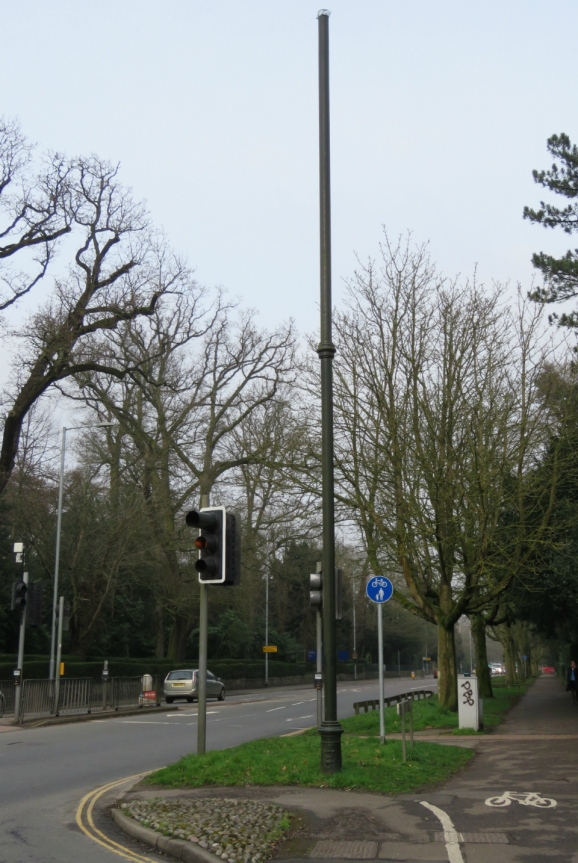
Newmarket Road at Christchurch Road
Another such pipe, by another of the city’s famous foundries – Boulton and Paul, is on Waverley Road. Listing stench pipes may sound train-spotterish except these are living reminders of our industrial history that should not be airbrushed from view in search of a uniform modern look. Only a year ago, the Cambridge News reported that residents on Hills Road/Queen Edith’s Way, Cambridge were – in their words, not mine – ‘kicking up a stink’ about plans to remove a tall, cast iron, Victorian stench pipe [15]. And last September the Eastern Daily Press reported that a tram standard had been removed for ‘safety reasons’ (Pah!) from the junction of West Pottergate and Heigham Road [16]. This matters because it was the very last post belonging to the Norwich Electric Tramways that had replaced horse-drawn omnibuses in 1900. The post that once carried its electricity was sturdy enough a century later when George Plunkett photographed it reincarnated as an electric lamp post. Now that link is lost.
![Heigham Rd former tram standard [7787] 2000-11-24.jpg](https://colonelunthanksnorwich.com/wp-content/uploads/2018/05/heigham-rd-former-tram-standard-7787-2000-11-24.jpg?w=529)
The last relic of the Norwich Electric Tramways 1900-1935 ©georgeplunkett.co.uk

In the early C19 the city was lit by oil lamps but the fuel was replaced by coal gas from about 1825-30. Although a few electric lamps had begun to appear at the end of the C19 it wasn’t until 1910-13 that the gas lamps were converted to electricity, except for a few in unadopted streets. This may explain the survival of the old gas lamp in St Giles Terrace, photographed by George Plunkett in 1955 [2]. It has been converted to electricity but retains its original lantern.
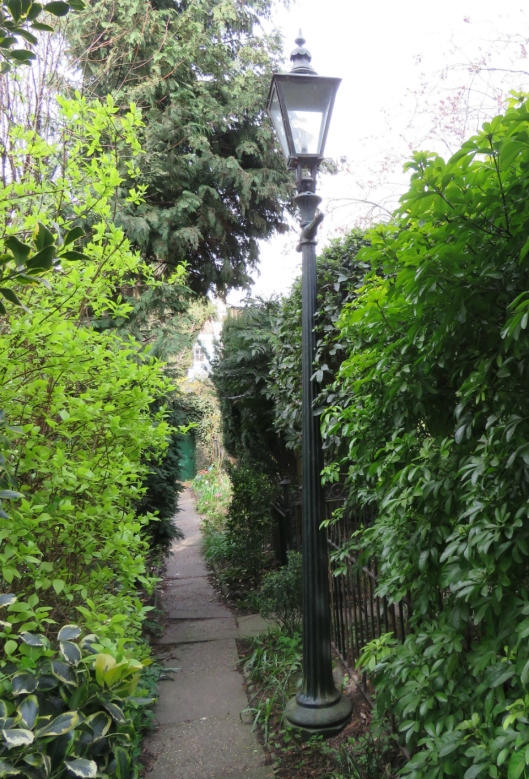
St Giles Terrace off Bethel Street
Walking the streets of Georgian or Victorian Norwich would undoubtedly leave mud on your boots and before entering the house this had to be removed with a boot scraper. The French are more direct in naming their scrapers decrottoirs, acknowledging that excrement (crotte) is a major component of ‘mud’ from streets populated by horses and dogs. A walk past the rich merchants’ houses in St Giles Street reveals several examples of cast-iron scrapers, either free-standing or (usually paired) set into the walls.

Now that most of us carry a mobile phone we can only wonder when phone boxes will become obsolete. The iconic model below, designed by Sir Giles Gilbert Scott, went into production in 1936 although modern ‘heritage’ versions are still made in the official colour, currant red [17].
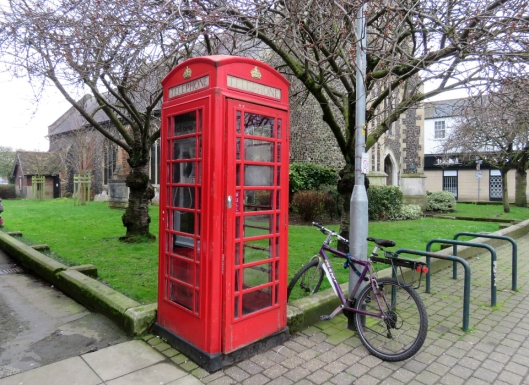
At the corner of St Saviour’s churchyard in Magdalen Street
There are several styles of red post box in the city. Left, is a Victorian ‘Penfold’ with an acanthus bud on top, designed by architect John Penfold. I remember a Penfold post box at the bottom of Guildhall Hill; the present one outside the City Hall is probably a replica made in the 1980s [17]. The modern post box derives from the version made in the reign of Victoria’s son, Edward VII (centre); the advantage was that the post slot was integral to the door so that no letters could skulk in the top of the box [17]. The current Elizabethan ERII box is virtually identical.

(L) Penfold-type, St Peter’s Street/City Hall. (C) Edward VII, Opie Street. (R) Elizabeth II, Unthank Road.
A personal favourite is the original Victorian wall box in Upper St Giles. This now fronts The Post Room antiques and interiors shop but I first encountered it when it belonged to the Upper St Giles sub-post office. Remember post offices?
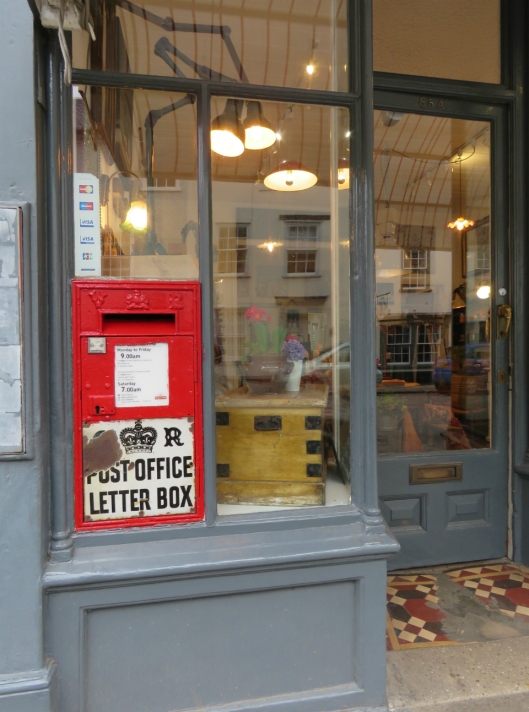
Bonus track
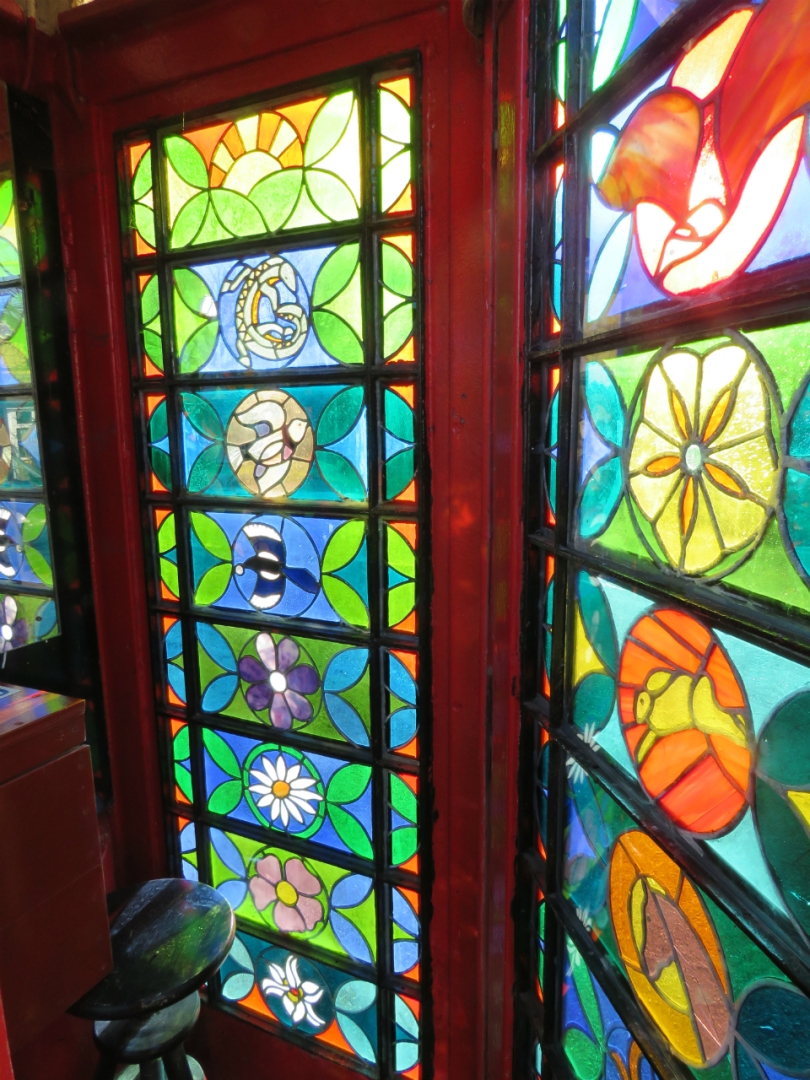
Villagers of Mellis, Suffolk, converted this £1 postbox to a colour therapy room
Sources
- http://norwichpreservationtrust.co.uk/gybsons-conduit-westwick-st-scheduled-ancient-monument/
- http://www.georgeplunkett.co.uk/Norwich/streetfurniture.htm An excellent resource for old Norwich street furniture.
- http://www.racns.co.uk/sculptures.asp?action=getsurvey&id=291
- http://www.waymarking.com/waymarks/WMJRMA_Dr_Harrington_Wyndham_Darrell
- http://johnsnowbicentenary.lshtm.ac.uk/about-john-snow/
- http://www.racns.co.uk/sculptures.asp?action=getsurvey&id=47
- http://www.christopherlong.co.uk/pri/wareffort.html
- https://colonelunthanksnorwich.com/2016/03/12/the-art-nouveau-roots-of-skippers-royal-arcade/
- https://www.norwich.gov.uk/downloads/file/3010/heigham_grove_conservation_area_appraisal
- https://www.norwich.gov.uk/downloads/file/3252/streetscape_design_manual (see page 25).
- https://colonelunthanksnorwich.com/2016/09/24/hands-off-our-bollards/
- https://norwichlanes.co.uk/about/
- http://racns.co.uk/sculptures.asp?action=getsurvey&id=806
- https://www.gracesguide.co.uk/Francis_and_Blyth
- https://www.cambridge-news.co.uk/news/cambridge-news/cambridge-stink-pipe-hills-road-13039347
- http://www.edp24.co.uk/news/last-link-to-norwich-s-tram-route-is-removed-from-busy-street-over-safety-concerns-1-5199416
- https://en.wikipedia.org/wiki/Red_telephone_box
Thanks to: Lesley Kant-Cunneen for information about ironwork in Clarendon Road and Alan Theobald for discussions about street furniture.

Excellent and enjoyable blog as usual.
LikeLiked by 1 person
Much appreciated, Julia
LikeLike
Layers of history- a true eye opener! Thank you Col. Unthank
LikeLiked by 1 person
Thank you for your help with street furniture Theo.
LikeLike
Excellent and informative. You certainly do not walk round the city with your eyes closed! Another one shared.
LikeLiked by 1 person
Thank you Haydn. It’s a surprise how much of old Norwich is left. (I can recommend norfolktalesmyths as a wonderful source of local fables).
LikeLiked by 1 person
Thanks Reggie 👍
LikeLiked by 1 person
I was surprised by how many of these I recognise. I’ve always wondered about the siting of the water pump at the bottom of St John Maddermarket’s churchyard – I shudder at the thought of drinking that water! I didn’t realise the significance of the red bollards in the Lanes either – too busy looking at the lovely sculptures on top.
LikeLiked by 1 person
Hi Sally. Yes, that pump made me think about the quality of water provided for the poor. You can see the attractions of beer.
LikeLike
Oh Reggie, I believe I fall in love with your posts more each time. I can’t wait to revisit Norwich this August and see it afresh thanks to your dedication and writing talents. Cheers from the St Clair river in Michigan.
LikeLiked by 1 person
I hope enough of the city remains as you remember it, Daniel. Best wishes from a sunny (yes!) Norwich.
LikeLike
A splendid set of ironwork – railings & posts was lost when the Castle Mall was constructed. These were erected by the ‘Tonnage Committee’ in 1832. A brilliant post (as always)
Don Watson
LikeLiked by 1 person
Hello Don. The old Duke Street iron bridge was recycled as the entrance to Castle Mall carpark and, on the same principle, it would be good to think that railings and post you mention are in storage somewhere, available for imaginative reuse. And thank you for the kind remarks. Reggie
LikeLike
Another enjoyable post. Thank you. I’m not sure when Gybson’s conduit was moved from its position on Westwick Street facing north. It was certainly there in the mid nineties. On the sculpture for Norwich site it says that ownership was transferred from Crown Estates in 2009. Could this have been when it was restored and moved again?
LikeLiked by 1 person
Thank you for the comment Ann. The Norwich Preservation Trust, in conjunction with the Norwich Society, bought Gybson’s Conduit from the Crown Estate. The Trust’s website gives the project dates as 2008-2011 so that would roughly tie in with your date of 2009. It was then restored “by grants from English Heritage, the John Jarrold Trust, the Paul Bassham Charitable Trust and Norfolk County Council”). Ref: http://norwichpreservationtrust.co.uk/gybsons-conduit-westwick-st-scheduled-ancient-monument/. My reading of the racns entry for the fountain is that it was moved from some unknown site to roughly the present site in 1868 BUT, on the opposite side of the wall. It now faces into the Anchor Quay development instead of out to the street.
LikeLike
What a wonderful post, Reggie! I really like your analogy, likening a city to a palimpsest and was able to recognise many of your examples too!
LikeLiked by 1 person
Hi Clare, Yes, it’s great that so many parts of Old Norwich still intrude. Let’s hope they continue to be cherished. Reggie
LikeLiked by 1 person
Yes, that is my hope too.
LikeLike
Wonderful post, Reggie! A great gathering of truly lovely street furniture. And I wholeheartedly agree that each example deserves preservation. But that parish pump and its “essence of churchyard” – yikes! That’ll stay with me for sometime.
LikeLiked by 1 person
Hi Katherine, That pump! It does make you think about how the poor obtained clean water. No wonder they drank small beer, beer, gin …
LikeLiked by 1 person
Your blog helps confirm how few English cities come near Norwich for sheer wealth of architectural detail. A novel view of St. Giles’. I seem to recall that pretzel ironwork design featuring on one or two other churchyards in the City where at that time they built retaining walls to accommodate street-widening- the North side of St. Lawrence’s in Westwick St. and the East side St. Peter’s Parmentergate on to King St. come to mind. You tend to remember this kind of thing if you have ever tried to draw it- perspective and all! By the way, the Chancel at St. Giles’ is entirely Victorian. it’s by Richard Phipson, who was Diocesan Architect and who restored the place in 1866-7. There used to be a contemporary plan of the Church inside showing how much he rebuilt or renewed- a great deal! The original Chancel was demolished in the late Tudor period by the father of famous composer Thomas Morley-Norwich boy made good! A propos of which, the person hired to whitewash out the Doom over the Chancel arch at the Guild Chapel, by the Puritan Town Council of Stratford upon Avon was one John Shakespeare, father of……………
LikeLiked by 1 person
Hello Mike, The ‘pretzel’ ironwork around Great St Giles is #121 by Boulton & Paul “As erected at St Giles’ Church, Norwich” and elsewhere around the city.
LikeLike